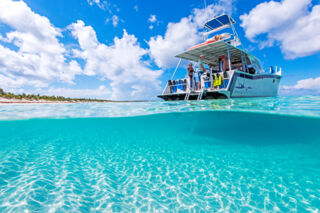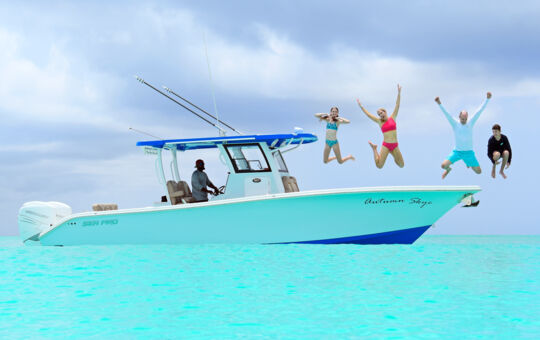Providenciales 10 Best Snorkeling Locations

Snorkeling is one of the best activities to do in the Turks and Caicos. There are some amazing reefs, shipwrecks, and coastlines to explore with a mask, fins, and a snorkel.
Providenciales, the main tourism island in the country, has a few beach reefs where it’s possible to snorkel from shore. Generally, however, the best reefs are only accessible by boat.
The first four reefs listed below can be visited by land and are located close to the beach. The others require a boat charter or snorkeling excursion to get to.
Every reef in the Turks and Caicos Islands is unique. The shore reefs near the Bight and Turtle Cove are excellent for reef fish, stingrays, and turtles. Meanwhile, the offshore barrier reef sites offer sea fan beds, sharks, and more impressive hard corals.
Read the Snorkeling Guide for more information. If you don't have your own gear, you can purchase some from one of the local water sports shops.
Snorkeling sites are listed in no particular order.

The Bight Reef
The Bight Reef—also known as Coral Gardens—is the most popular snorkeling reef on Providenciales. It is located on the western end of Grace Bay off the Bight Beach. This relatively simple system starts right off the beach and continues out for about 400 feet (122 m) offshore. The Bight Reef definitely isn’t the best reef in the Turks and Caicos, but it’s a great place to see fish and is easily accessible.
The Bight Reef is a habitat for many turtles, stingrays, and a spectrum of colorful reef fish. Even the best scuba diving sites often don’t have as diverse a menagerie of approachable fish.
Several resorts are within walking distance of the Bight Reef. These include Beaches Turks and Caicos, the Windsong, Coral Gardens Resort, West Bay Club, and Wymara Resort.

Smith’s Reef
Smith’s Reef is a complex collection of reefs in the Turtle Cove area of Providenciales. It is an exceptional site for those who are comfortable snorkeling on their own. The area tends to see fewer visitors than the Bight Reef, and thus offers better seclusion.
There are three beach accesses for Smith’s Reef. Each spot offers a different atmosphere, ranging from coral heads right off the beach to lush seagrass beds and large reef networks further offshore.
Wildlife that’s commonly sighted at Smith’s Reef includes eagle rays, stingrays, turtles, lobsters, and dozens of types of fish.

Malcolm’s Road Beach
The remote Malcolm's Road Beach is located on the undeveloped western coast of Providenciales. The secluded setting and sheltered coastline has a beach that’s very unlike the others on the island. Fascinating reefs start right off the beach and continue out to the wall, the name for the edge of an underwater plateau where depths drop rapidly from about 50 feet (15 m) into the thousands.
Due to the seclusion and the limited number of other people who may be present, it’s not a recommended snorkeling site for beginners.
Malcolm’s Road Beach is also the best spot for freediving from shore on Providenciales. Freediving, which should only be practiced after professional training and with a trained buddy, is the water sport of diving while holding your breath. It can be a fun and tranquil way to explore the reefs of the Turks and Caicos. A collapsed underwater Thunderdome from a TV game show is located off the beach, and is one of the most popular freediving sites in the islands.

Northwest Point National Park
The Northwest Point Marine National Park on Providenciales is an expansive protected area that's home to many great snorkeling sites, which represent a wide collection of underwater environments. There are barrier reef sites, lush seagrass beds, small coastal caves, and many types of colorful corals to discover.
Nearly the entire western coast of Providenciales is undeveloped. The exclusive Amanyara resort is the exception.
Northwest Point does have some great nearshore snorkeling. The deeper sites are often a first stop for the liveaboard scuba diving yachts that explore the country's untouched remote reefs. However, it’s easiest and best to visit via boat with a knowledgeable guide, as it can be hard to find the best spots.

Leeward Reef
The barrier reef at Leeward Cut is the single most popular snorkeling boat tour destination in the Turks and Caicos Islands. It is located on the northeastern end of Providenciales.
Leeward Cut Reef is a prime example of the country's barrier reef system. It supports systems of sea fan beds, small gullies and caves, and the spur and groove reef formations that lead out to the edge of the underwater plateau that supports the islands.

West Caicos Marine National Park
The western side of West Caicos—the West Caicos Marine National Park—is home to some spectacular snorkeling sites. There are small caves, sea fan beds, vibrant reefs, and plenty of sea life. Visibility tends to be excellent as well, which really adds to the underwater serenity and surreal experience.
West Caicos is about a 45-minute trip from Providenciales by boat. Most scheduled and public boat cruises do not visit the island, so it’s necessary to arrange a private boat tour or yacht charter to visit. Private trips can definitely be worth the extra cost, especially for large families, as they allow you to spend the day doing exactly what you want.
In addition to the snorkeling, the West Caicos attractions include some pristine and secluded beaches, the Yankee Town historical site, and Lake Catherine Nature Reserve.

The Caicos Banks
One underappreciated snorkeling environment in the Turks and Caicos is the collection of countless small coral heads and reefs found in the shallow Caicos Banks between Providenciales and South Caicos. The quality of the reefs and underwater visibility generally improves towards East Caicos and South Caicos, yet some great spots are within a 10- to 15-minute boat ride from Providenciales.
Many of the reefs are quite small, yet they are home to incredible sights. One reef may have unbelievable numbers of juvenile Caribbean spiny lobsters, while the next reef could have a few baby lemon sharks circling it.
Trips heading out to the reefs in the Caicos Banks can also stop at the La Famille Express wreck off of Long Bay Beach. There are small starfish on the hull of the wreck, and the giant prop and anchor are interesting. While this can be a fun place to snorkel on a calm day, the area is frequented by reckless jet ski drivers. As a result, it can be dangerous.

The Grace Bay Reefs
Snorkeling boat cruises often visit the Grace Bay reefs, which are located between Grace Bay Beach and the barrier reef. These collections of coral heads are most impressive off the Bight Beach area, and usually combine good visibility and plenty of interesting corals. While you'll typically see fewer fish here than at some other sites, these reefs are well worth a visit.
The Grace Bay reefs are located close to many of the resorts on Providenciales, so boat travel times are typically quite short.

Wiley Cut
Wiley Cut is a passage through the barrier reef off the western side of Providenciales, and is a spectacular snorkeling location. It offers crystal-clear ocean water and some of the finest sea fan beds in the country. The area is quite remote. Dive boats transiting to Northwest Point and West Caicos are the only tour or excursion vessels that typically transit the cut.
The reefs at Wiley Cut are vibrant and colorful, with bright yellow and purple sea fans, corals, and fish that include wrasse, blue tangs, butterfly fish, damselfish, jacks, yellowtails, queen triggerfish, squirrelfish, angelfish, nurse sharks, stingrays, and eagle rays.
Not many tour companies visit Wiley Cut to snorkel. Big Blue Collective does visit the western side of Providenciales on longer adventures, as do some private charters.

Flamingo Creek Bay
Flamingo Creek Bay is another excellent reef in the Northwest Point Marine National Park. It is located near Wiley Cut and south of Malcolm’s Road Beach and Amanyara resort. The adjacent land and wetlands are part of the Frenchman’s Creek Nature Reserve. Together, they create an incredible environment.
Flamingo Creek Bay is quite difficult to access due to its remote location and the poor quality of the track leading to the beach, yet it’s the single best beach snorkeling site on Providenciales.
Two reef systems are found a short distance off the limestone coast. The northern reef offers abundant reef fish, yellow and purple sea fans, and gullies full of interesting creatures. The southern reef (although close by) is quite different, with masses of hard corals and sponges.
Snorkeling Charters




